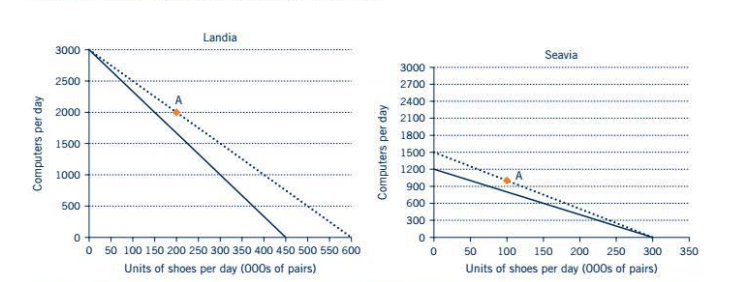Chapter 11: International Trade of Goods
Exports : Goods or services produced domestically but sold abroad.
Imports: Goods or services produced abroad but sold domestically.
Trade surplus is when a country’s level of exports exceeds its level it imports.
Trade deficit is when a country’s level of imports exceeds its level of exports.
Rapid increases in technology have decreased the costs of transporting goods and services and have resulted in increased international trade and globalization in the world.
When people, firms, and even countries trade according to their comparative advantage, both trading parties can be made better off.
For example, lets take two countries Seavia and Landia. The opportunity cost of producing shoes is lower in Seavia than it is in Landia because the opportunity cost of producing 1 unit of shoes in Seavia is 4 computers, whereas the opportunity cost of producing 1 unit of shoes in Landia is 6.67 computers.
- Because Seavia can produce shoes at a lower opportunity cost than Landia, Seavia has comparative advantage relative to Landia in producing shoes.
- Because the cost of producing a computer in Landia is lower than it is in Seavia, Landia has comparative advantage relative to Seavia in producing computers.
The terms of trade describes the price of rate of change of one good for another In order for two countries to be better off by trading, the terms of trade need to be between the two countries' opportunity costs of production.
Specialization and trade allows both countries to move beyond the confines of their production possibilities.
Taking the two countries seavia and landia again,

The solid lines represent the PPFs for Landia and Seavia.
- Landia produces only computers and Seavia produces only shoes and the two countries trade with one another at the rate 200 units of shoes for 1,000 computers or 1S = 5C, the two countries can consume at levels outside the its PPF as shown by the dotted consumption possibilities curves.
- Point A lllustrates one possible consumption level for the two countries, if Landia trades 1,000 computers to Seavia for 200 units of shoes.
The fact that the largest category of U.S. goods exported is capital goods- machines, equipment, industrial and aircraft engines tells us that the U.S. has comparative advantage relative to many other countries in producing these goods.
]]One reason that international trade is controversial is that it involves costs and benefits. Although most economists would agree that the overall benefits of free trade outweigh its overall costs, the distribution of these costs and benefits is unequal.]]
Imports of goods and services generate an increase in supply and lower prices for consumers but at the same time cause a decrease in quantity supplied and lower prices for domestic producers.

Protectionism is the limiting of free trade between countries by using tariffs, quotas, or other regulations.
Opponents of free trade sometimes argue that it is important to protect the jobs of workers in industries facing competition from imports. While it is true that restricting the imports of certain goods and services does protect jobs in those areas, this protection comes at a very high cost for a large number of other co-owners, households, and businesses in the economy.
A tariff is a tax on imported goods or services.
A quota is a restriction on the quantity of a good that can be imported into a country. The United States imposes quotas on a variety of items ranging from dairy products to tobacco to peanut butter to cotton.
- The U.S. Customs Service and the U.S. Department of Agriculture (for dairy products) are the agencies primarily responsible for administering U.S. import quota laws.
Regulations that either directly or indirectly restrict trade can take many forms, including technical or content requirements placed on imports as well as subsidies for domestically produced goods.
Although countries engage in restricting international trade, they also engage in agreements to reduce trade barriers between one another. Trade liberalization activities take on many forms, primarily including regional trade agreements and participation in the World Trade Organization's international trade agreements.
Regional trade agreements are agreements by countries in a region to reduce trade restrictions among themselves.
- they arise when countries in a region join together to reduce trade restrictions among their members.
- Trade barriers between the members of regional trade agreements are eliminated or greatly reduced.
]]The World Trade Organization (WTO) is an international organization of 153 member states with the goal of reducing trade barriers throughout the world.]]
- ]]The WTO acts as the official arbiter of trade disputes between countries and is the negotiator and administrator of WTO trade agreements ratified by its members.]]
- ]]In addition to these primary activities, the WTO engages in research on the extent and impacts of trade on various outcomes.]]
International trade can generate costs for workers and firms who do not have comparative advantage in production.
- Businesses who face losses from international trade are often strong supporters of trade restrictions or protectionist policies, which can include tariffs, quotas, and other regulations.